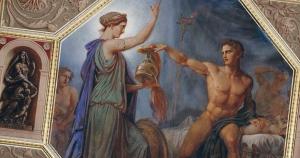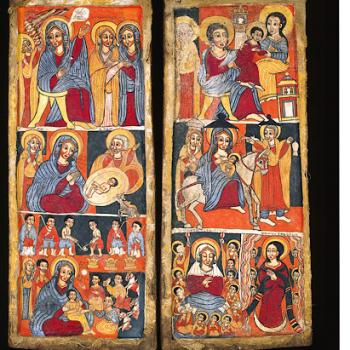I asked for new voices and got some outstanding writers! Today we hear from the erudite James R. Harrington.
 James R. Harrington earned his M.A. in Ancient History at California State University Fulleron and is a member of the Torrey Honors Institute. James has been a classical educator in a variety of settings over the past thirteen years. He lives in Houston with his wife, Sharon, and their daughter.
James R. Harrington earned his M.A. in Ancient History at California State University Fulleron and is a member of the Torrey Honors Institute. James has been a classical educator in a variety of settings over the past thirteen years. He lives in Houston with his wife, Sharon, and their daughter.
Harrington began with a series on shields in classical literature and now moves to witches as a theme.
On shields, Mr. Harrington responded to thoughts on his first post. Harrington wrote about the shield of Herakles, He continued to the shield of Aeneas and followed up on that post. We turned to a shield in Ovid. He concluded with Quintus and a follow up.
Now he turns to witches with a second post , a third, a fourth, a fabulous fifth, a sixth, a seventh, an eighth, a ninth, a tenth,and now eleven:
The Julio-Claudian dynasty reigned in the Hellenistic style as “Sons of God” and “Saviors,”bringing order to the chaos of the Mediterranean world. As a part of that order, the Julio-Claudians suppressed destabilizing forces such as magic and divination. During the reign of Tiberius, and particularly under his successors, Gaius Caligula and Claudius, a sect within Second Temple Judaism began challenging the official line. Leaders of The Way, such as Simon/Peter and Saul/Paul, defiantly claimed that the true “Son of God” and “Savior” was an obscure backwater preacher by the name of Jesus of Nazareth, who had been executed for political agitation. As one proof of their claim, Peter and Paul didn’t outlaw witchcraft; they declared war on it.
Accounts of powerful confrontations between Peter and Paul and ancient practitioners of magic abound in the earliest organized account of The Way, Acts. It is significant that Acts does not show Peter and Paul forbidding magic so much as annihilating it with rival displays of power. Paul strikes the magus Bar-Jesus blind when he attempts to bar Paul’s access to the Roman proconsul, Sergius Paulus.* Peter has but to threaten the infamous occult figure, Simon Magus, with eternal damnation, and he crumples.** Where Augustus seized and burnt magical texts, new converts to The Way in Ephesus voluntarily burn their magic books, sparking a riot among devotees of Diana of Ephesus.***
Who, then, are the “witches” of Acts that would eventually merge with the Roman and Germanic witch–traditions to produce the Witch of European folklore?° Acts portrays Simon Magus as a grafter trying to buy the power of the Holy Spirit with money. Bar-Jesus is described as a false prophet and client/hanger-on of a Roman proconsul. The Ephesians who confessed to practicing magic and burned their magic books are city-dwellers who converted to Christianity during Paul’s stay in the city. The two remaining figures are a group of Jewish priests called the Seven Sons of Sceva, who misuse Jesus’ name during an exorcism and are violently beaten by the possessed, and a slave girl, whose masters sue Paul for damages when he exorcises a prophetic evil spirit from her.°° In short, the “witches” of Acts are a cross-section of the citizens of the Eastern Roman Empire. Some are victimizers, and some are oppressed themselves. Either way, Peter and Paul have no need to pass an imperial statute against them; they simply call on Jesus of Nazareth and strip the “witches” of their power.
Centuries would pass between the early years of The Way that became Christianity and the great Witch Trials of the Renaissance. Figures like Saint Anthony would declare war on the Devil and make their physical invasion of the Egyptian desert a spiritual invasion of Hell. Popes and theologians would wrestle with the link between witchcraft and heresy. As we end today’s discussion, it is sufficient to note the contrast between Peter and Paul’s calm assurance in the face of the “witches” of Acts and the fearful frenzy of their spiritual descendants.
————————————————
* Acts 13:6-12
** Acts 8:9-24. For Simon Magus as an occult figure see Charles Williams, Witchcraft. Berkeley: Apocryphile Press, 2005. pp. 31-34.
***Williams, p. 19; Acts 19:18-19
°For possible reconstructions of this process see: Pam Grossman, Waking the Witch: Reflections on Women, Magic, and Power. New York: Gallery Books, 2019. pp.72-85, and Williams, pp. 13-75.
°°see Acts 19:13-17 and 16:16-19












